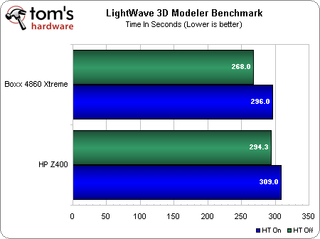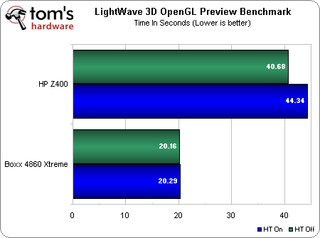Boxx Technologies 3DBOXX 4860 Workstation
Benchmark Results: 3D Animation
Thanks to its extensive use in visual effects for television and feature films, along with its almost complete replacement of 2D animation in animated features, 3D animation is probably the highest-profile and best-recognized use of workstations. It may not necessarily represent the largest market, but when there are companies deploying hundreds and thousands of boxes for this purpose, it can still be considered very influential.
We are using a mix of off-the-shelf workstation tests, and metrics developed in-house, as the in-house tests tend toward more demanding workloads that give us flexibility in adopting newer software versions.
NewTek LightWave 3D 9.6
We have three different custom tests that run in LightWave 3D 9.6. Each test is designed to be repeatable in a specific portion of the software
LightWave Modeling Test
This test uses a plug-in script to clone details onto polygonal sections of the Tom’s Hardware logo object created for workstation evaluation.

The result in this test is somewhat unexpected, as many of the other benchmarks show that the six-core Core i7-980X running at 4.15 GHz can deliver results more than 100% faster. Here we only see a 10% improvement, even though the difference in clock speed alone should give this processor-bound measurement a much wider spread.
Stay on the Cutting Edge
Join the experts who read Tom's Hardware for the inside track on enthusiast PC tech news — and have for over 25 years. We'll send breaking news and in-depth reviews of CPUs, GPUs, AI, maker hardware and more straight to your inbox.
Our dual-socket Xeon 5600-series review yielded results very close to these. The theory is that this test is more sensitive to memory performance than some of our other benchmarks, and we’re planning on taking a look at this later.
For reference, the HP Z400 workstation included in most of this review's charts employs a Xeon W3520 CPU running at 2.66 GHz and an AMD FirePro V5700 graphics card. You can find our review of that platform right here.
LightWave OpenGL Preview Test
This test generates an OpenGL Preview in Layout of the entire 600-frame animation. Layout stores this animation in RAM, for real-time playback. This feature (and features like it in other 3D applications) is used most when the system cannot play back the animation in real time. In many cases, older systems with memory limitations could not store an entire 600-frame animation for playback in memory at full resolution, so animators would preview segments, save the preview in compressed form to disk, or combinations of both.

Through a combination of sheer processing speed and the power of the Quadro 5000 graphics card, the 3DBOXX 4860 Xtreme actually generates the OpenGL preview in faster-than-real-time. The animation is 600 frames at 24 frames per second, so it's run time is 25 seconds. The system takes just over twenty seconds to generate the preview. Also notable on this system is the narrowing of the difference between the Hyper-Threading-enabled and -disabled times (0.6% difference instead of 9%).
LightWave Rendering Test
Four frames were selected from the animation for rendering. Each frame was chosen for its specific properties, representing different load levels. We end up with a simple render involving global illumination, ray-traced and shadow-mapped shadows, and motion blur.
The first frame, for instance, has a minimal amount of geometry visible to the camera, minimal motion blur, and because of the position of the camera on the object, the maximum occlusion of non-visible geometry. The second frame has a fair amount of visible geometry in the scene, far less geometry occlusion, and the maximum motion blur effect. The third frame has the most geometry visible to the camera at the largest size, with motion blur occurring, while the fourth has lots of geometry visible, but at a small size, and almost no motion blur.

This test demonstrates one of the largest difference between this system and the HP machine. The 3DBOXX 4860 XTREME comes in an average of 136% faster than the previously-tested machine, due to its two additional processor cores and the 56% difference in clock rate between the processors.
Current page: Benchmark Results: 3D Animation
Prev Page Hardware Setup And Benchmarks Next Page Benchmark Results: Autodesk 3ds Max 2011, Cinebench, VUE, And MatchMover-
nebun what a cheap cpu cooler they have....really...for 8k they could have installed a better cooling systemReply -
utengineer mayankleoboy1though if i were to take each component separately and build our own system, it would be cheaper.You forget, the cost of a commercial PC includes service, support, and licensed certifications.Reply
-
nforce4max I wouldn't purchase this workstation. First you can build a better base machine for the fraction of the cost. Second you can purchase on your own the software you require or pirate. Third there is a flaw, yes there is always the temptation of mounting the hard drives in that manor but isn't recommended due to the uneven wear on the spindle that can lead to early failure.Reply -
For this price, I'd go with a workstation from a major player (ex. HP or similar). You could easily build a dual socket workstation with similar (or better) overall performance; remember that many apps that require this level of hardware are optimized for Xeon instruction sets and 8+ threads. Additionally, you're software vendors would actually support their products on a system running within spec. Simply put, this is a toy not an enterprise class productReply
-
wiyosaya utengineerYou forget, the cost of a commercial PC includes service, support, and licensed certifications.Licensed certifications may be confidence inspiring to some, however, I think they are a waste of money. It is just a different form of branding that can be marketed at what is usually an expensive premium. Think THX certification. It was expensive in consumer audio and video, however, in my opinion, it has had it's 15-minutes of fame.Reply
Most Popular

